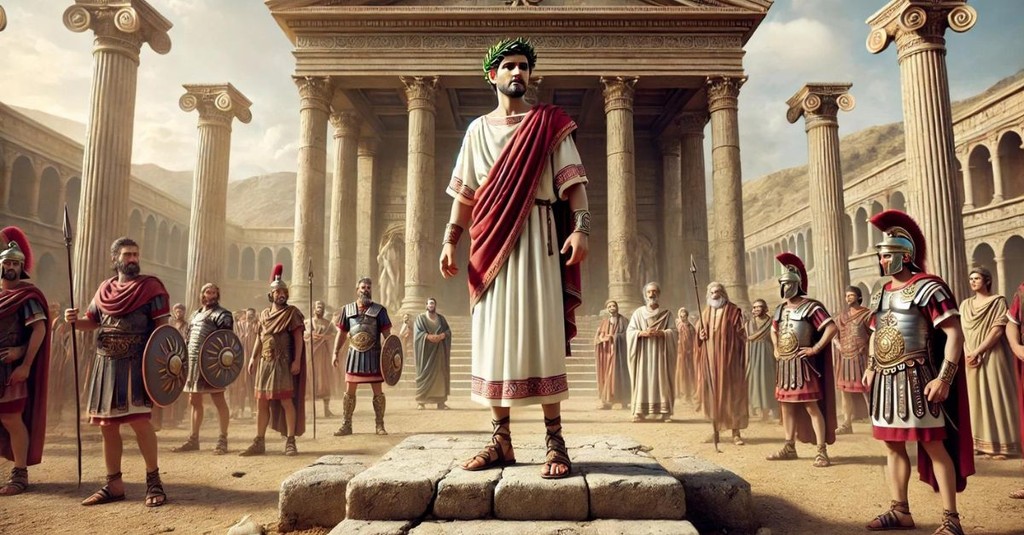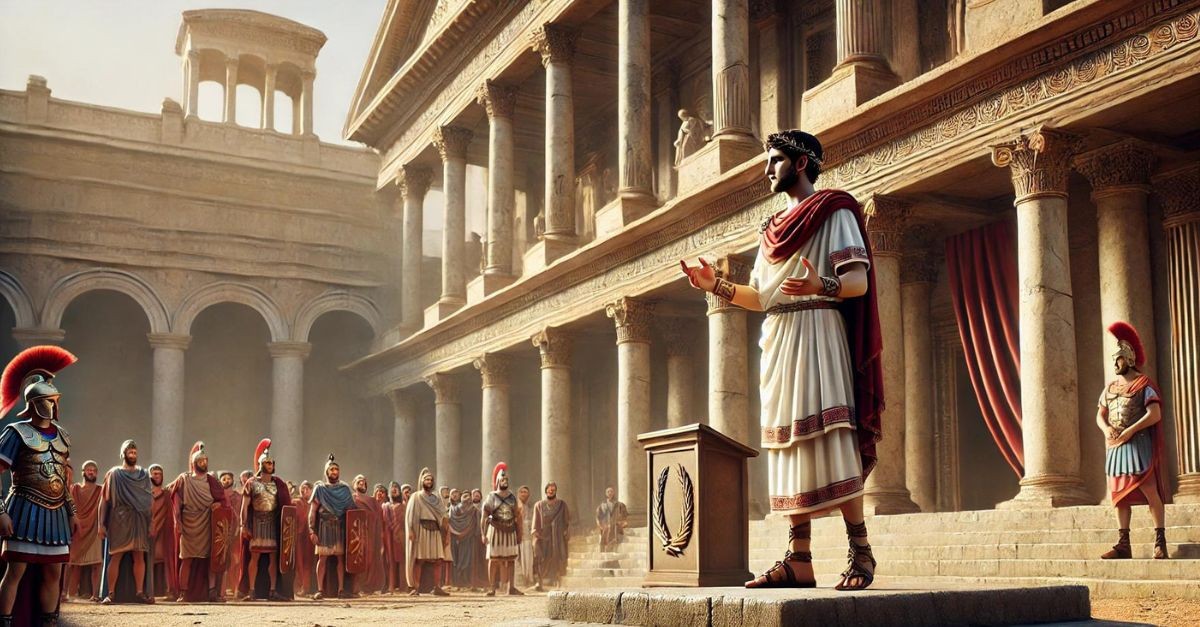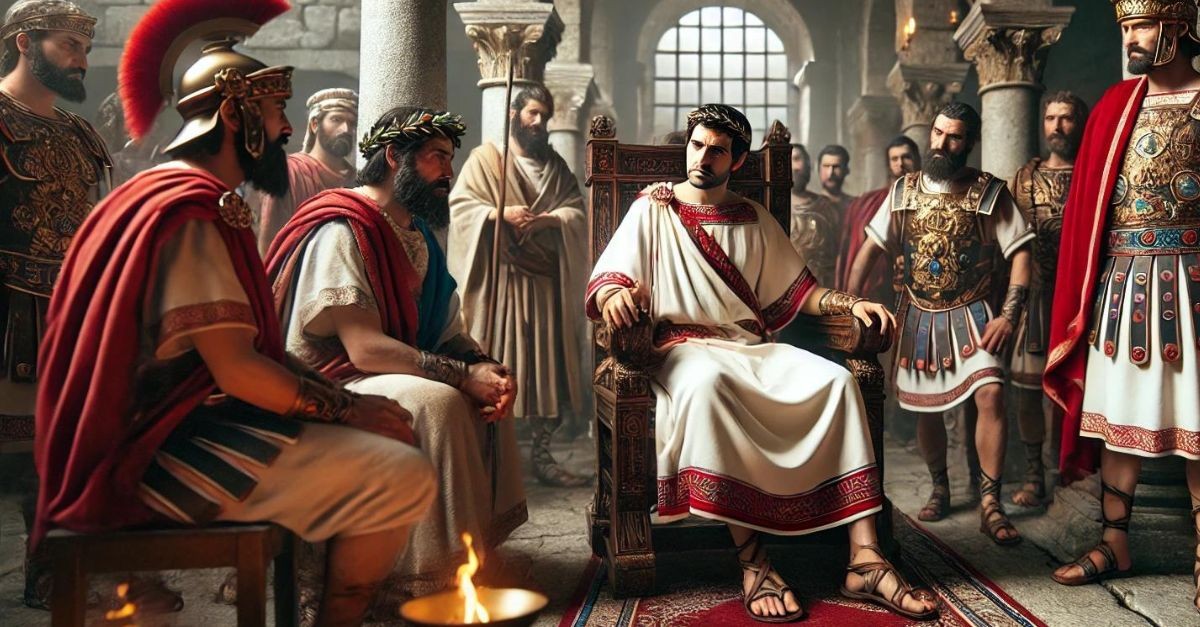
“You brought me this man as one who was inciting the people to rebellion. I have examined him in your presence and have found no basis for your charges against him.” - Luke 23:14
It is a name that really needs little in the way of introduction or explanation. It is broadly known, even by non-believers. Pontius Pilate. His name is even mentioned in the Nicene and Apostles’ Creeds – thus, never to be forgotten by Christ-followers. Of course, if it were not for the gospels, he quite likely would have never been known beyond the somewhat obscure secular history of writers such as the Jewish historian Flavius Josephus, along with a handful of other lesser-known historical works.
But that singular event from scripture made him famous. That relatively short moment in history when he oversaw part of the sham trial of Jesus and gave him up to be crucified. According to the gospel accounts, Pilate was quite reluctant to crucify Jesus and tried multiple times to have him released. Ultimately, though, Pilate caved to the demands of the religious leaders – despite seeing through their charade.
Photo Credit: Image created using DALL.E 2024 AI technology

Pontius Pilate and His Role in Jesus' Time
It is important, perhaps, to lay out the political and secular events taking place during that period, as well as the decades leading up to that time. It is quite safe to say that the Roman Empire had a great deal of influence on the entire era. Jesus’ birth came at the height of the Roman rule over a rather expansive area, and throughout most of their empire, hope and optimism seemed to be the dominant attitude, even of their subjects. Indeed, Rome ensured “pax Romana” – Roman Peace – was maintained, albeit at the point of a sword. However, there existed relative peace and stability across the entire Roman Empire, which lasted more than 200 years – beginning under the reign of Augustus Caesar.
Augustus had raised the expectations of what an authoritative leader could attain – and what a society under him might achieve. In fact, it was Augustus who first stole the Greek word for Gospel – good news – and applied it as a label for his new world order. The empire declared him a god – to the point of establishing rites of worship.
In fact, the Romans seemed to adopt many of the ways of the Greeks – dressing like them, played Greek sports, built buildings like the Greeks and even spoke Greek. To loyal subjects, Augustus offered peace and security from outside enemies. By and large, the people conquered by Rome accepted their dominance because of the peace and stability provided.
Everywhere that is, except in Israel. Israel seemed to be one region that simply would not cooperate. The Jews refused to accept the multiple gods of the Greeks/Romans – and chose to abide in their one true God.
Jews had resisted the Hellenization imposed on them by the Greek culture more than a century prior – fighting fiercely to maintain their faith. The rule of the madman Antiochus resulted in an open revolt led by the Maccabees – whose victory Jews celebrate to this day at Hanukkah. The Jews succeeded at holding off foreign invaders for nearly a century, but the Roman steamroller finally moved into Israel. Then, after thirty years of fighting off continuous rebellion, the Romans installed a local “king” as their puppet – Herod the Great, who reigned until the birth of Jesus.
Even during that time, Galilee seemed to be a breeding ground for revolutionaries. Even the man who founded the Zealots – the aggressive anti-Roman faction – came from Galilee. Galilee was more or less known as the region of “country bumpkins” – backward both educationally and intellectually. They spoke the common language – Aramaic – as someone from the deep, very, deep south or, say, Brooklyn might speak English. A heavy, thick accent that betrayed their roots. And other Jews considered them lax and uninformed in spiritual matters.
“Nazareth! Can anything good come from there?” Nathanael asked. - John 1:46
Yet despite this – or maybe because of it - Jesus was hardly viewed as a threat by the dominant powers.
While the Sadducees quite readily cooperated with Rome – as they did the Hellenists - the Pharisees walked a more balanced line. Trying to cooperate yet retain their faith. They had already had run-ins with Rome, including one instance where 800 Pharisees had been crucified in a single day. Despite this, they remained faithful to the high standards of the Law. Yet – they, too, while passionately expecting the Messiah, were very skeptical of anyone claiming to be the Messiah – especially from Galilee. Pharisees hesitated to buy in too quickly to any claimed miracle worker who might again bring disaster on them from Rome.
"Then one of them, named Caiaphas, who was high priest that year, spoke up, 'You know nothing at all! You do not realize that it is better for you that one man die for the people than that the whole nation perish.'” - John 11:49-50
Photo Credit: Image created using DALL.E 2024 AI technology

1. Pilate Had the Title of Prefect
Enter Pontius Pilate
According to secular accounts of his life, Pilate was a Roman knight of the Samnite clan of the Pontii – from where, of course, came the name “Pontius.” Pilate served as the fifth prefect (governor) of Judea from 26 – 36, but little is known of his life prior to that appointment. Pilate did not exactly earn his way into his position. Many scholars believe that Pilate was closely linked to powerful Pretorian Prefect Sejanus – who either appointed Pilate himself or coerced Tiberius to appoint him. There are those who believe he married into the family of Caesar and thus was given the assignment.
All accounts of Pilate’s leadership – both secular and in the gospels – consistently portray the man as a headstrong, strict authoritarian. His allegiance was clearly to Rome and to Caesar but often applied his own decisions to challenging events – sometimes even creating those challenges.
Here are a few things about Pilate we do know:
Title of Prefect
The title of prefect implies that Pilate’s rule was primarily military. However, his troops were intended more as a militant police force than a military one. Thus, Pilate’s duties extended beyond military matters and included judge, jury, and executioner. This ultimately led to the Jews bringing Jesus to Pilate, as they were not allowed to execute anyone.
"Pilate said, 'Take him yourselves and judge him by your own law.' 'But we have no right to execute anyone,' they objected." -John 18:31
Photo Credit: Image created using DALL.E 2024 AI technology

2. Pilate Appointed the Jewish Priest
Caiphas was the Jewish high priest appointed by Pilate. Annas, his father in law, had been high priest prior to this appointment. This is why, after the betrayal by Judas, the men bound Jesus and took him first the house of Annas – then to the palace of Caiaphas.
"Then the detachment of soldiers with its commander and the Jewish officials arrested Jesus. They bound him and brought him first to Annas, who was the father-in-law of Caiaphas, the high priest that year." - John 18:12-13
3. Pilate Did Not Live in Jerusalem
Pilate did not live in Jerusalem - he lived in Caesarea, the headquarters of the Roman army in the region. He only happened to be in Jerusalem at the time of Jesus’ arrest and trial – likely due to the large number of Jews in the city for the Passover festival.
4. Pilate Was Not Popular with the Pharisees
Jesus’ trial was not the first run-in between Pilate and the Pharisees. Early in his term as Prefect, Pilate had every intention of abolishing the Jewish laws. He introduced images of Caesar on banners and brought them into Jerusalem, contrary to Jewish law. Multitudes of Jews descended upon the city to dissent, and after six days of protests, Pilate ordered his men to surround the Jews with weapons at the ready – and execute them upon his command. But the Jews ultimately threw themselves on the ground, laid their necks bare, and said they would take death rather than accept the offense of images of false gods. It is said Pilate was deeply impacted by their firm resolve to their laws and relented. Thus, Pilate ordered the images of Caesar to be carried from Jerusalem back to Caesarea from where they came.
Photo Credit: Image created using DALL.E 2024 AI technology

5. Pilate Should Have Listened to His Wife
It is often overlooked or quickly bypassed, but Pilate’s wife – whose is unnamed in the gospel accounts – warned her husband to be careful. She went so far as to identify Jesus as “that innocent man.” Of course, as many husbands know who have been married for any length of time – Pilate should have listened to his wife.
" While Pilate was sitting on the judge’s seat, his wife sent him this message: 'Don’t have anything to do with that innocent man, for I have suffered a great deal today in a dream because of him.'” - Matthew 27:19
6. Saint Procla – Pilate’s Wife
The Eastern Orthodox Church depicts Pilate as having accepted Jesus as “king of the Jews,” and Pilate and his wife died as Christian believers. In fact, Pilate’s wife – who they refer to as Saint Procla – is venerated by the Oriental Orthodox, Eastern Orthodox, and Eastern Catholic churches. The Oriental Orthodox Church also celebrates Pilate as a saint. Perhaps her warning to Pilate was heartfelt.
7. What Does INRI Mean?
INRI, which we see on crosses, is an acronym for Iesus Nazarenus Rex Iudaeorum – which is Latin for “Jesus of Nazareth, King of the Jews.” This was an inscription that Pilate had ordered to be placed on the cross of Jesus during his crucifixion. It was written in Latin, Aramaic, and Greek. The sign was then nailed to the cross to be seen by all who passed. Of course, the Pharisees protested – and, perhaps for the first time, Pilate would not relent.
"Pilate had a notice prepared and fastened to the cross. It read: Jesus of Nazareth, the king of the Jews. Many of the Jews read this sign, for the place where Jesus was crucified was near the city, and the sign was written in Aramaic, Latin, and Greek. The chief priests of the Jews protested to Pilate, 'Do not write "The King of the Jews," but that this man claimed to be king of the Jews.' Pilate answered, 'What I have written, I have written.'” - John 19:19-22
Photo Credit: Image created using DALL.E 2024 AI technology

8. The Trial of Pontius Pilate
According to Josephus, Pilate was removed from office because of what Rome considered a violent and cruel suppression of an uprising in Samaria. Pilate had the offenders executed without proper trial. He was called to Rome by Tiberius, who died before Pilate arrived. Therefore, Pilate stood trial before Caligula – who, as punishment, ordered Pilate to kill himself.
Pilate Served God’s Purpose
In the book of Exodus, during the time of the plagues which God set upon Egypt, God sent a message to Pharoah through Moses:
"For by now I could have stretched out my hand and struck you and your people with a plague that would have wiped you off the earth. But I have raised you up for this very purpose, that I might show you my power and that my name might be proclaimed in all the earth." - Exodus 9:16
In his letter to the believers in Rome, Paul referred to this verse when he was describing God’s will (Romans 9:17). Paul added this:
"Therefore God has mercy on whom he wants to have mercy, and he hardens whom he wants to harden." - Romans 9:18
Clearly, it was God’s will that Jesus be crucified. Only in that way could mankind be redeemed. Thus, Pilate served God’s purposes and really had little choice in the matter. This was confirmed by Jesus in his words to Pilate:
"Jesus answered, 'You would have no power over me if it were not given to you from above. Therefore the one who handed me over to you is guilty of a greater sin.'” - John 19:11
The gospels leave no doubt that Pilate had every desire to release Jesus – and his wife clearly wanted him to release Jesus. But what we don’t read in the gospels is anything about the heart of Pilate after turning him over to be crucified. Haven’t you always wondered why Pilate had the sign posted proclaiming Jesus of Nazareth, King of the Jews – for all to read, not just at that moment, but for all eternity? Could he simply have been taking a stab at the Pharisees? Perhaps. Maybe even likely.
But then again, perhaps the Lord, in using Pilate, had mercy on him and ultimately saved his soul. Or when Jesus said, “Father, forgive them, they do not know what they are doing.” – Pilate was a part of “them.” Is it possible Pilate ultimately found the answer to his question – “What is truth?”
Only God knows.
“You are a king, then!” said Pilate.
Jesus answered, “You say that I am a king. In fact, the reason I was born and came into the world is to testify to the truth. Everyone on the side of truth listens to me.”
“What is truth?” retorted Pilate. With this he went out again to the Jews gathered there and said, “I find no basis for a charge against him.
- John 18:37-38
“I am the way and the truth and the life. No one comes to the Father except through me.” - John 14:6
Photo Credit: Getty/shuang paul wang

Greg doesn’t pretend to be a pastor, a theologian, or a Bible expert, but offers the perspective of an everyday guy on the same journey as everyone else – in pursuit of truth.
Greg can be reached by email or on Facebook @ Greg Grandchamp - Author.
Originally published Monday, 29 July 2024.
